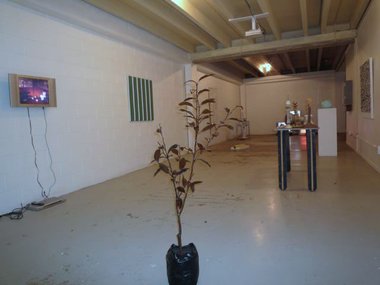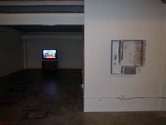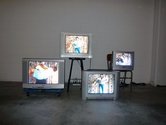Mark Amery – 19 March, 2010
And yet there's no more popular conversation topics in the circles I pass through than the drought of bigger group shows of excellent new art in public galleries, or the lack of artist project spaces outside the institutions.
On The Table
6 College St.
Te Aro
JJ Morgan and Co
3 Cruikshank St.
Kilbirnie
News of the Auckland launch of a publication documenting the life of Wellington artist space Show, rubs in not just how much that particular space is missed (the beautifully designed catalogue testament to Show’s curatorial quality), but how bereft many in Wellington feel of programmes highlighting the best or freshest contemporary art.
For a small city, that may seem greedy. It’s now the tenth anniversary or thereabouts of the establishment of The Adam, Michael Hirschfield, Film Archive and Enjoy galleries, and more recently the council-run Toi Poneke Gallery. Certainly we don’t lack for institutions. And yet there’s no more popular conversation topics in the circles I pass through than the drought of bigger group shows of excellent new art in public galleries, or the lack of artist project spaces outside the institutions.
Jim and Mary Barr’s On the Table physical space (a corollary from virtual space Over the Net and On the Table) is a positive response to this. While their current second group exhibition is from their own collection, their first of Dan Arps, Campbell Patterson and Sriwhana Spong in November last year was arranged with Michael Lett. There are plans for other initiatives to cuckoo in their nest this year.
JJ Morgan and Co in Kilbirnie is another self funded initiative that’s recently opened, with the current exhibition series brought together by Lovelab Projects and its curator Melanie Moreau. While the Over the Net space is a first floor rectangular gallery (about the same size as Toi Poneke), JJ Morgan is basically a small mechanics or panelbeater’s garage, offering a nice and grungy concrete shell with good drive in access and plenty of height. Perfect for projects. They welcome submissions.
The Lovelab Projects focus is stated as working towards strengthening local connections, and their first exhibition (its title a nice analogy for this focus: Spreading Blankets on the Beach) involved partnerships with local dealers Suite and Mary Newton. Allowing a single curator to put together a programme of exhibitions seems like a smart model. I note (unlike Show and the Hirschfield) that there doesn’t appear to be a selection committee assisting the owners in steering future programming. A good thing or not? Committees can be a tiresome sign of institutionalisation in action, but the spaces’ wish to network might warrant continued wider consultaton.
First up at On The Table is Slow Dance. It feels like a run-of-the-mill strong Barr collection show, as is seen with the DPAG initiated touring exhibitions Good Works and Reboot. Indeed it is one that feels all the better for being able to do away with the public gallery’s insistence on elaborate explanations of the groupings of works and endless labels. The art is left is talk to us and between itself.
That the show resembles something I feel I’ve seen before is a little dissapointing - albeit tempered by the rewards that excellence provides. It’s a superior mixtape. Whether it’s a cracker Rohan Wealleans, from what was I thought a rather variable last Hamish McKay show, or a Sarah Jane Parton video Slow Dancer (which gives the show its name), previously presented at City Gallery, they do show a great eye.
There are only a few surprises and challenges. It features some firm Barr favourites, who were (from memory) well represented in these collection shows and have had plenty of exposure at Wellington public galleries with solo projects: Dashper, et al., Parekowhai, Killeen, Armanious, Van Hout and others. Dwyer and Wealleans meanwhile have been well represented in Wellington by Hamish McKay.
Of the most interest are the three artists who haven’t had the exposure in Wellington you’d hope for. Martin Creed’s Work number 312 a lamp going on and off, positioned nicely in a small closet room under the staircase, infects through modest domestic means the whole character of the exhibition. Its determined slow metronomic click plays to the exhibition title, encouraging the slowing down of pace to dance with the works - in particular to let the time dependant video works get under your skin. And it’s nice to have the sole ‘overseas work’ sitting quietly in the corner shedding intermittent light on the locals.
It plays nicely in tandem with Parton’s video which depicts the artist, crutches by her side, left dance partner-less amongst the otherwise empty seats in a corner of the hall at a school disco, balloons and the flecks of the mirror ball playing over her desolation. Perfectly pitched, I very much like how Parton’s work doesn’t shy from playing out time or hinting at a narrative happening both here and elsewhere.
I also can’t help but find the hint of a narrative to the entire exhibition. As you enter there is Mikala Dwyer’s plaque of gold star stickers to the right (it gave its title to the Good Work touring show), and as balance a Ronnie Van Hout silver spacesuit hanging to the left. These together with the Parton, Campbell Patterson, Dashper and et al. works made me feel like I was in some high school student’s surreal dreamlife, of mixed hopes and frustrations. I imagine the small Armanious and Wealleans sculptural works as some bastard children of the subconscious from the kiln in the school art room.
Campbell Patterson’s work reminds me of the awkward and embarrassing New Zealand coming-of-age ritual of having your photo taken with your date for the school ball in all your lurid get-up before you leave - usually, as here, in front of the living room ranchslider curtains. Except here, Patterson films himself, as the title tells us, ‘Lifting my mother for as long as I can’.
There are four versions of Patterson lifting his mother (once was enough for me, unless 7up-like he came back 10 years, rather than one year, later). In each, a beautiful tension is physically balanced between love and pain, performance and intimacy, and between tenderness and ‘the things I do for my strange son’. It’s utterly charming, magnetic, and in its own way as full of empathy as the Pieta, which it reverses.
The best is to be found around the corner, with a Simon Denny video Deep Sea Vaudeo from 2009. Screened on a ‘90s style large screen TV I was first drawn in by a slow dodgy tracking shot of a conga line of television sets (facing each other’s backs and showing us their girth), which also tracked the evolution and thinning of the television set over 20 years. The video turns out to be on the set of some showroom, with an array of cheap audiovisual presentation techniques, including the deep sea marine life images on screen that are ubiquitous with these displays.
Then, just as I’m ruminating on how the shallowness of this technology and how it has to be balanced from something from the deep, and the death of two dimensional space, Denny starts running a critical commentary on the work that echoes my own. Cleverly employing a range of stock commercial sales techniques, it completely and brilliantly undercuts your attempts to be deep yourself and reduce you to shallow voyeur. The work has the ability to zombie you in while keeping the brain ticking over. Here’s one artist we don’t see often enough in Wellington.
Meanwhile at JJ Morgan are two glitter carpets and a pile of fake roses from Mark Curtis (The Diana Suite, Burnt with Tea Mix). Deliciously gaudy and dirty all at the same time, these work are all the better for inhabiting corners in a grimy garage. I’d last seen a Curtis glitter carpet as part of Prospect 2004 (R.I.P) at the Adam Art gallery, and this is far stronger for its interesting meditation on the emptiness of the Princess Diana fetish and the swept up leftovers of the ‘80s camp era. The work remains principally decorative however rather than really involving, but nevertheless is beautifully executed, well placed (other than the pile of roses, which is poked round a corner far too politely when they could have been strewn) and utterly bedazzling. I love the dissolving edges to the work here, plus its slow accumulation of grit and dust.
Both of these spaces are open for limited hours over this weekend (11am to 5pm Saturday only, followed by an artist talk at JJ Morgan, 1-4pm both days at Over the Net). Then these particular exhibitions close.
Images from Over The Net:
First image: From the left, Sarah Jane Parton Slow dance ‘92, Julian Dashper Untitled 1991, Michael Parekowhai The moment of Cubism 2009, (rear) L Budd Untitled (No 1) 1995 (obscured) The Estate of L. Budd EE100.2 Edition released by The Estate of L. Budd 2009, L Budd Sticky label 1992, Hany Armanious Turns in Arabba 2005, Rohan Wealleans Aqua bike stand 2001, Rohan Wealleans Beast head gem holder 2005, et al. Untitled (model) 2002 and Rohan Wealleans Big square brainy painting 2009
Second image:Left Simon Denny Deep sea vaudeo 2009 right, et al. Untitled (model) 2002
Third image: Campbell Patterson Lifting my mother for as long as I can 2006, 2007.2008, 2009
and JJ Morgan and Co with two works by Mark Curtis.
Many thanks to the artists, Jim and Mary Barr and Justin Jade Morgan.





 Advertising in this column
Advertising in this column Two Rooms presents a program of residencies and projects
Two Rooms presents a program of residencies and projects



This Discussion has 0 comments.
Comment
Participate
Register to Participate.
Sign in
Sign in to an existing account.